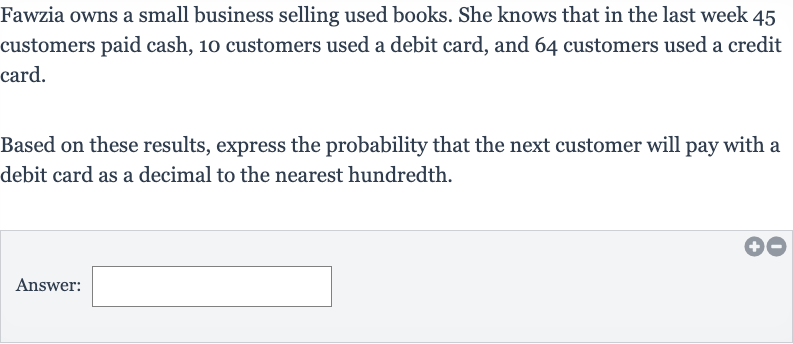AI tutor
Welcome to Bytelearn!
Let’s check out your problem:

Fawzia owns a small business selling used books. She knows that in the last week customers paid cash, customers used a debit card, and customers used a credit card.Based on these results, express the probability that the next customer will pay with a debit card as a decimal to the nearest hundredth.Answer:
Full solution
Q. Fawzia owns a small business selling used books. She knows that in the last week customers paid cash, customers used a debit card, and customers used a credit card.Based on these results, express the probability that the next customer will pay with a debit card as a decimal to the nearest hundredth.Answer:
- Determine total number of customers: Determine the total number of customers.To find the probability of a single event, we need to know the total number of events. In this case, we add the number of customers who paid with each method to find the total number of customers.Total number of customers Number of customers who paid cash Number of customers who used a debit card Number of customers who used a credit cardTotal number of customers
- Calculate total number of customers: Calculate the total number of customers.Now we perform the addition from Step to find the total number of customers.Total number of customers = Total number of customers =
- Calculate probability for debit card payment: Calculate the probability that the next customer will pay with a debit card. The probability is the number of favorable outcomes divided by the total number of possible outcomes. In this case, the favorable outcomes are the number of customers who used a debit card, and the total number of possible outcomes is the total number of customers. Probability (Paying with debit card) = Probability (Paying with debit card) =
- Convert probability to decimal: Convert the probability to a decimal.To express the probability as a decimal, we perform the division from Step .Probability (Paying with debit card) =
- Round decimal to nearest hundredth: Round the decimal to the nearest hundredth.To express the probability to the nearest hundredth, we round the decimal from Step to two decimal places.Probability (Paying with debit card)
More problems from Find probabilities using the binomial distribution
QuestionGet tutor help
QuestionGet tutor help
QuestionGet tutor help
QuestionGet tutor help
QuestionGet tutor help
QuestionGet tutor help
QuestionGet tutor help
QuestionGet tutor help
QuestionGet tutor help
QuestionGet tutor help
